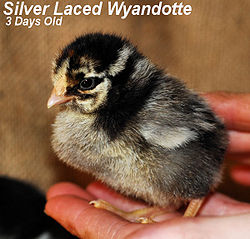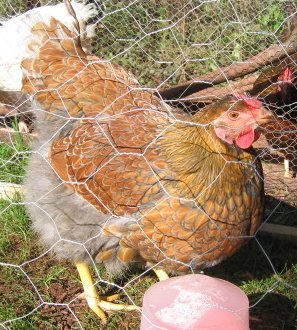.gif)
Wyandotte (chicken)
Encyclopedia
The Wyandotte is a breed
of chicken
originating in the United States. The first examples of the breed appeared in 1870s. Wyandottes are a docile, dual-purpose breed kept for their brown eggs and for meat. They appear in a wide variety of color patterns, and are popular show birds. The Wyandotte lays pale brown or tan eggs and usually has a white ring of feathers around its neck. Wyandotte hens are devoted mothers.

and confinement in a run. Hens occasionally become broody. They are also very vocal, uttering soft clucks on a regular basis.
The breed has been noted for being incredibly friendly, and combined with their easy maintainability are a favorite with those new to raising chickens.
The silver laced wyandotte has white feathers with black edges to every feather, an effect called lacing. The tail is black and they should have yellow legs. The silver laced was developed in New York state in the early 1870s and was admitted to the standard in 1883. The silver laced wyandotte was the base for all other colors.
Golden Laced:
The golden laced wyandotte is a golden color with black around the edge of every feather and black tail. Joseph McKeen of Wisconsin was the originator of the Golden Laced Wyandotte. In 1880 he crossed Silver Laced Wyandotte females with a large "Black Red" patterned fowl of unknown origin called the Winnebago
. The variety was admitted to the American Standard in 1888.
 Blue Laced Red:
Blue Laced Red:
The blue laced red is a buff/red color with a blue that looks just like grey around the edge of every feather.
Buff Laced:
The buff laced is buff but with white around the edge of the feathers.
White:
The white is white all over. The whites are the rarest color in the UK.
Black:
The black is black all over.
Buff:
The buff is a buff color all over. A buff is like a ginger orange color.
Columbian:
Columbian is white, but with a black tail, black wing tips and the neck is mainly black with some white.
Partridge:
A red color but with three black stripes, meeting at the middle of the feather and then going outwards at an angle in the hen, and the cock
looks like a typical farmyard cock.
Silver Pencilled:
Like the partridge, but with a silver undercolor in the hen and the cock is a white color but with bits of black in there until the tail and the wing which are black.
Blue:
The hen is blue all over but the cock is black with the tail and wing blue on some birds.
Barred:
The barred, in both genders, has feathers which have black and white stripes across the width of the feather
, all over the body.
Mille Fleur:
The mille fleur wyandotte is a dark brown color with black crescents with white spots on the tips.
Buff Columbian:
Like the Columbian except buff.
Red:
The red wyandotte is a dark red/brown all over.
Breed
A breed is a group of domestic animals or plants with a homogeneous appearance, behavior, and other characteristics that distinguish it from other animals or plants of the same species. Despite the centrality of the idea of "breeds" to animal husbandry, there is no scientifically accepted...
of chicken
Chicken
The chicken is a domesticated fowl, a subspecies of the Red Junglefowl. As one of the most common and widespread domestic animals, and with a population of more than 24 billion in 2003, there are more chickens in the world than any other species of bird...
originating in the United States. The first examples of the breed appeared in 1870s. Wyandottes are a docile, dual-purpose breed kept for their brown eggs and for meat. They appear in a wide variety of color patterns, and are popular show birds. The Wyandotte lays pale brown or tan eggs and usually has a white ring of feathers around its neck. Wyandotte hens are devoted mothers.
Appearance
The Wyandotte is a medium sized bird with a rose comb and clean legs. The chicken feathers are broad and loosely fitting. The area around the vent is very fluffy. The legs are yellow, although some silver laced may have grey.Colors
There are eight colors recognized by the APA (American Poultry Association) which are golden laced, silver laced, white, black, buff, Columbian, partridge and silver penciled. In bantams there is also buff Columbian, black breasted red, blue red, lemon blue, barred,brown red, and birchen that are recognized by the American Bantam Association. However, there are more colors than that which are either recognised by similar organisations in other countries like the PCGB (Poultry Club of Great Britain). These colors include blue laced red and buff laced. Overall there are 17 colors.
Characteristics
The Wyandotte is a breed that suits both free rangeFree range
thumb|250px|Free-range chickens being fed outdoors.Free range is a term which outside of the United States denotes a method of farming husbandry where the animals are allowed to roam freely instead of being contained in any manner. In the United States, USDA regulations apply only to poultry and...
and confinement in a run. Hens occasionally become broody. They are also very vocal, uttering soft clucks on a regular basis.
The breed has been noted for being incredibly friendly, and combined with their easy maintainability are a favorite with those new to raising chickens.
Utility aspects
The hens (females) will lay around 200 eggs a year with an exceptional hen laying around 240 eggs a year. The eggs are brown or tinted. The hens weigh around 6 pounds and the cocks weigh around 8½ pounds. The hens also make great setters. It is sometimes difficult for natural insemination to occur, due to the number and thickness of feathers in the tail area. For the same reason, they are prone to accumulation of feces on vent-area feathers that needs to be regularly washed off, or the vent could become clogged.Approximate weight (metric)
| Cock | 3.2 kg |
| Hen | 2.95 kg |
| Cockerel | 3.4 kg |
| Pullet | 2.5 kg |
| Rooster | 1.7 kg |
| Hen | 1.3 kg |
Variations
Silver Laced:The silver laced wyandotte has white feathers with black edges to every feather, an effect called lacing. The tail is black and they should have yellow legs. The silver laced was developed in New York state in the early 1870s and was admitted to the standard in 1883. The silver laced wyandotte was the base for all other colors.
Golden Laced:
The golden laced wyandotte is a golden color with black around the edge of every feather and black tail. Joseph McKeen of Wisconsin was the originator of the Golden Laced Wyandotte. In 1880 he crossed Silver Laced Wyandotte females with a large "Black Red" patterned fowl of unknown origin called the Winnebago
Winnebago (chicken)
Winnebago is a 19th-century American chicken breed of unknown origin. It appears to have been a precursor to the modern Golden Wyandotte.In by John H...
. The variety was admitted to the American Standard in 1888.

The blue laced red is a buff/red color with a blue that looks just like grey around the edge of every feather.
Buff Laced:
The buff laced is buff but with white around the edge of the feathers.
White:
The white is white all over. The whites are the rarest color in the UK.
Black:
The black is black all over.
Buff:
The buff is a buff color all over. A buff is like a ginger orange color.
Columbian:
Columbian is white, but with a black tail, black wing tips and the neck is mainly black with some white.
Partridge:
A red color but with three black stripes, meeting at the middle of the feather and then going outwards at an angle in the hen, and the cock
Cock
-Ornithology:* the male of most species of bird, but especially** A Rooster or cockerel, the male of the domestic fowl or chicken, Gallus domesticus*The English name of several species of bird incorporates the word cock, such as...
looks like a typical farmyard cock.
Silver Pencilled:
Like the partridge, but with a silver undercolor in the hen and the cock is a white color but with bits of black in there until the tail and the wing which are black.
Blue:
The hen is blue all over but the cock is black with the tail and wing blue on some birds.
Barred:
The barred, in both genders, has feathers which have black and white stripes across the width of the feather
Feather
Feathers are one of the epidermal growths that form the distinctive outer covering, or plumage, on birds and some non-avian theropod dinosaurs. They are considered the most complex integumentary structures found in vertebrates, and indeed a premier example of a complex evolutionary novelty. They...
, all over the body.
Mille Fleur:
The mille fleur wyandotte is a dark brown color with black crescents with white spots on the tips.
Buff Columbian:
Like the Columbian except buff.
Red:
The red wyandotte is a dark red/brown all over.

